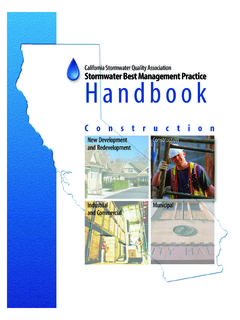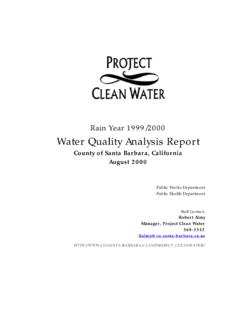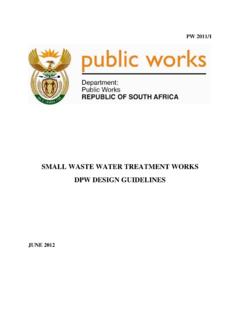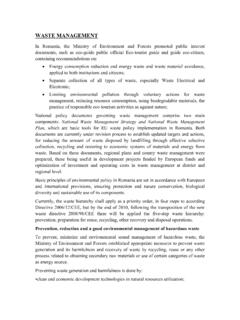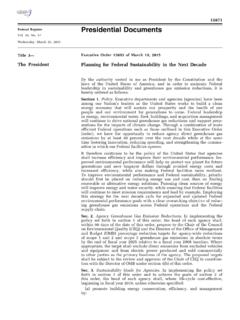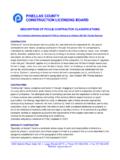Transcription of Guide to Composting Horse Manure July 02
1 A Guide TO Composting Horse Manure (Adapted from: A Guide to Composting Horse Manure by Jessica Paige, ) Horse Manure makes great fertilizer that can be used on pastures, but should not be applied just before or during a rainstorm. On average, a well-managed pile can be composted in one or two months in the summer and three to six months in the winter. To ensure efficient Composting , follow the tips below. Please note that a permit may be required for your Composting your Horse Manure . See the Permits Required section at the end of this document for more information.
2 Choose a good location for your compost pile(s). Choose a well drained site on level ground in a location that is convenient to your stall and paddock areas. It is also useful to choose a site with convenient access to water which will be needed to moisten the compost pile periodically. Any permanent animal enclosure should be constructed in such a way that runoff water can be controlled and confined. Animal pens should be placed 50 feet or more from the edge of a water source, even when placed on level ground or when utilizing a grassy strip.
3 During winter rains when the soil gets saturated and the grass is dormant, additional structures such as berms or rention structures are needed to direct runoff away from the water source. If animals must be housed closer than 50 feet from water, a lagoon or retention pool should be constructed to trap and retain runoff. Please note: all animal structures must be located at least 10 feet from any water source, although a greater distance is strongly recommended. Build the optimum pile size. Your pile must be at least 3 feet high.
4 For best results, try for a pile 5 to 7 feet square on the bottom rising to 3 or 4 feet high. Choose the right pile ingredients. The organisms that decompose the material in a compost pile need carbon for energy and nitrogen for growth. It is important to supply both kinds of materials in roughly the right proportions. The ideal carbon to nitrogen ratio for Composting is between 25:1 and 30:1 (with carbon being the higher number). On its own, Horse Manure is about the ideal ratio. However, you may need to adjust the amount of carbon/nitrogen within your pile depending on the type of bedding used.
5 High carbon materials include plant materials such as straw, wood chips, shavings, sawdust, and leaves. Materials that are high in nitrogen include animal by-products like Manure and blood meal, along with grass clippings and hay. Most composters use trial and error to attain a good carbon to nitrogen ratio; however, it is also helpful to understand the underlying mathematical concepts. Please be aware that the formula below is simplified for use by home composters. Example of determining C:N ratio (2-input pile): You have 5 pounds of grass clippings (C:N ratio = 20:1) You have 5 pounds of leaves (C:N ratio = 40:1) You have a total of 10 lbs.
6 Of material: 50% are grass, 50% are leaves 1. Multiply the % of grass in the pile by the C:N ratio of grass = A. 2. Multiply the % of leaves in the pile by the C:N ratio of leaves = B. 3. Add A + B to determine your C:N ratio. Example: (50% 20/1) + (50% 40/1)= 10 + 20 = 30 ---> which in fraction notation is 30/1 or 30:1. The C:N ratio is 30:1 Common Compost Ingredients & C/N Content Alfalfa hay Nitrogen 13:1 Bark Carbon 100:1 Blood meal Nitrogen 4:1 Coffee grounds Nitrogen 20:1 Cornstalk Carbon 60:1 Grass clippings Nitrogen 12-19:1 Leaves Carbon 40-80:1 Horse Manure Nitrogen 25:1 Pig Manure Nitrogen 5:1 Cow Manure Nitrogen 20:1 Oat straw Carbon 74.
7 1 Seaweed Nitrogen 19:1 Straw Carbon 40 - 100:1 (usually about 80:1) Wood chips Carbon 500:1 *From: Maintain airflow through the pile. If you have a tractor, turning the pile at regular intervals, especially during the first few weeks after building the pile, will speed up the decomposition process considerably. If you are not able to turn the pile with a tractor, you can insert a couple of five-foot PVC pipes into the center of the pile like chimneys. Use a drill to put some holes into the pipes-approximately a half-inch in diameter at six-inch intervals.
8 Another method of achieving airflow through the pile is the aerated static pile method (see Composting Options). Monitor temperature. You can buy a long-stemmed compost thermometer at local nurseries or home and garden stores to monitor your compost piles. Most compost piles begin at a lower temperature range (about 50 F-110 F) and then increase to a higher temperature range (110 F-160 F) before gradually dropping to ambient air temperatures. These high temperatures are necessary to speed up the rate of decomposition and to kill weed seeds and diseases.
9 At least several days of temperatures between 135 F and 150 F are recommended. If you find your pile is reaching temperatures above 160 F, you may want to reduce the size of your pile. Manage moisture. Unsuccessful attempts at Composting often result from a failure to maintain the proper moisture conditions. Too much or too little water can greatly impact your piles performance. To determine if your pile contains the right amount of moisture, use the squeeze test. Take a handful of material from the interior of the pile and give it a squeeze.
10 A handful of material should feel damp like a wrung-out sponge, not dripping wet. If you pick up a handful of material and it drips without being squeezed, it is too wet. If your pile is too wet, turn the pile to release excess water. If the material appears dry and crumbles after squeezing, it is too dry. Add water to the pile to moisturize. If the material retains its clumped shape after squeezing without releasing excess water and your hand is damp, then it is just right for Composting . Add water when needed. If you turn your compost pile, you can water it down with a garden hose when you turn it.
